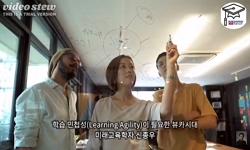Agility has been recognized by various researchers as an effective management capability for uncertain environments, suggesting that agility plays a role as a major source of managerial superiority and can improve organizational performance. However, ...
http://chineseinput.net/에서 pinyin(병음)방식으로 중국어를 변환할 수 있습니다.
변환된 중국어를 복사하여 사용하시면 됩니다.
- 中文 을 입력하시려면 zhongwen을 입력하시고 space를누르시면됩니다.
- 北京 을 입력하시려면 beijing을 입력하시고 space를 누르시면 됩니다.

정부기관의 민첩성이 성과에 미치는 영향에 관한 연구: 우편유통을 중심으로 = A Study on the Effect of Agility of Government Agencies on Performance : Focusing on mail distribution
한글로보기부가정보
다국어 초록 (Multilingual Abstract)
Agility has been recognized by various researchers as an effective management capability for uncertain environments, suggesting that agility plays a role as a major source of managerial superiority and can improve organizational performance. However, the empirical research on this issue is insufficient and the empirical research including the conceptual study on agility is still insufficient. Basically, this study is a follow-up study of Kim(2016). The purpose of Kim(2016) is to investigate the effects of agility and to develop agility scale in government research institutes. In this study, it can be said that there is a difference in that agility is a study of whether it plays a role as an important management means of government institutions. As a result of the analysis, it was possible to verify a positive relationship between the agility and the organizational performance at the 1% significance level. However, when the agility and organizational performance were assumed to be multidimensional, a slightly different result was obtained. If performance against competitors is a dependent variable, only employee capacity and flexible structure have a statistically significant relationship. If new business performance is a dependent variable, only value and policy, flexible structure and cooperative structure are statistically significant. The agility dimension, which has a significant positive effect regardless of the type of the performance variable, is a flexible structure, which is similar to the view of the previous studies that presented flexibility as a key concept of agility.
국문 초록 (Abstract)
민첩성은 불확실한 환경에 대한 효율적인 관리역량으로 다양한 연구자들에 의해 인정받고 있는데, 그들은 민첩성이 주요한 경영우위원천의 역할을 수행하며, 이를 통해 조직성과를 향상시...
민첩성은 불확실한 환경에 대한 효율적인 관리역량으로 다양한 연구자들에 의해 인정받고 있는데, 그들은 민첩성이 주요한 경영우위원천의 역할을 수행하며, 이를 통해 조직성과를 향상시킬 수 있다고 제안하였다. 그러나 이에 대한 실증적 연구가 미흡하며, 특히 민첩성에 대한 개념적 연구를 포함해서 실증적 연구가 여전히 미흡한 상황이다. 기본적으로 본 연구는 김종근(2016)의 연구에 대한 후속연구의 성격이 강하며, 해당 연구에서는 정부기관의 민첩성 척도 개발 및 진단이 주요한 연구목적이었으나, 본 연구에서는 민첩성이 정부기관의 중요한 관리수단으로서 역할을 수행하는지에 대한 연구라는 점에서 차별점을 가진다고 할 수 있다. 연구대상은 우정사업본부의 종사원이며, 회귀분석을 통해 단일차원 및 다차원으로 구분하여 연구가설을 검증하였다. 분석결과, 민첩성과 조직성과 모두 단일차원으로 가정할 경우 1% 유의수준에서 통계적으로 유의한 긍정적인 관계를 검증할 수 있었으나, 민첩성과 조직성과 모두 다차원으로 가정할 경우 다소 상이한 결과가 도출되었다. 경쟁사대비 성과를 종속변수로 가정한 경우 종업원 역량과 유연한 구조만이 통계적으로 유의미한 관계를 보였으며, 신사업 성과를 종속변수로 가정한 경우 가치와 정책, 유연한 구조 및 협력적 구조만이 통계적으로 유의미한 관계를 보였다. 성과변수의 종류와 상관없이 유의미하게 긍정적인 영향을 미치는 민첩성 차원은 유연한 구조인 것을 알 수 있으며, 이는 민첩성의 핵심개념으로서 유연성을 제시한 기존 연구들의 견해와 유사한 결과라고 할 수 있다.
참고문헌 (Reference)
1 지성구, "환경 불확실성과 마케팅 민첩성, 마케팅 성과의 관계에 관한 연구" 대한경영학회 22 (22): 1013-1035, 2009
2 김종근, "정부기관 조직민첩성 진단모형에 관한 연구:우정서비스를 중심으로" 한국서비스경영학회 17 (17): 45-63, 2016
3 곽기영, "정보기술역량과 조직학습이 기업성과에 미치는 영향: 조직민첩성의 역할을 중심으로" 한국경영학회 40 (40): 1075-1108, 2011
4 이형석, "실증연구방법" 한경사 2014
5 김정욱, "실시간 기업구현을 위한 비즈니스 민첩성의 결정요인에 관한 실증적 연구" 한국경영과학회 30 (30): 83-97, 2005
6 김병욱, "실시간 기업구현을 위한 비즈니스 민첩성 결정 요인" 세종대학교 대학원 2007
7 Wendler, Roy, "What Constitutes an Agile Organization? - Descriptive Results of an Empirical Investigation" Technische Universitt Dresden 2014
8 Aitken, J., "Understanding, Implementing and Exploiting Agility and Leanness" 5 (5): 59-74, 2002
9 Kisperska-Moron, D., "The agile capabilities of Polish companies in the supply chain: An empirical study" 118 (118): 217-224, 2009
10 Wendler, R., "The Structure of Agility from Different Perspective" 1165-1172, 2013
1 지성구, "환경 불확실성과 마케팅 민첩성, 마케팅 성과의 관계에 관한 연구" 대한경영학회 22 (22): 1013-1035, 2009
2 김종근, "정부기관 조직민첩성 진단모형에 관한 연구:우정서비스를 중심으로" 한국서비스경영학회 17 (17): 45-63, 2016
3 곽기영, "정보기술역량과 조직학습이 기업성과에 미치는 영향: 조직민첩성의 역할을 중심으로" 한국경영학회 40 (40): 1075-1108, 2011
4 이형석, "실증연구방법" 한경사 2014
5 김정욱, "실시간 기업구현을 위한 비즈니스 민첩성의 결정요인에 관한 실증적 연구" 한국경영과학회 30 (30): 83-97, 2005
6 김병욱, "실시간 기업구현을 위한 비즈니스 민첩성 결정 요인" 세종대학교 대학원 2007
7 Wendler, Roy, "What Constitutes an Agile Organization? - Descriptive Results of an Empirical Investigation" Technische Universitt Dresden 2014
8 Aitken, J., "Understanding, Implementing and Exploiting Agility and Leanness" 5 (5): 59-74, 2002
9 Kisperska-Moron, D., "The agile capabilities of Polish companies in the supply chain: An empirical study" 118 (118): 217-224, 2009
10 Wendler, R., "The Structure of Agility from Different Perspective" 1165-1172, 2013
11 Simpson J. A., "The Oxford English Dictionary" OxfordUniversity Press 1989
12 Upton, D., "The Management of Manufacturing Flexibility" 7 (7): 72-89, 1992
13 Swafford, P. M., "The Antecedents of Supply Chain Agility of A Firm : Scale Development and Model Testing" 24 (24): 170-188, 2006
14 Christopher, M., "The Agile Supply Chain: Competing in Volatile Markets" 29 : 37-44, 2000
15 McAfee, A., "That Makes a Competitive Difference" 99-107, 2008
16 D'Aveni, R. A., "Strategic supremacy through disruption and dominance" 40 (40): 127-135, 1999
17 Venkatraman, N., "Strategic Orientation of Business Enterprises" 35 (35): 942-962, 1989
18 Zelbst, P. J., "Radio Frequency Identification Technology Utilization and Organizational Agility" 52 (52): 24-33, 2011
19 조용구, "RTE 구현 정보시스템과 민첩성 역량 그리고 기업성과의 관계" 엘지씨엔에스 6 (6): 113-127, 2007
20 Nunnally, J. C., "Psychometic Theory" McGraw-Hill 1978
21 Reed, K., "Organizational Flexibility in Australia" 9 (9): 457-477, 1998
22 Agarwal, A., "Modeling agility of supply chain" 36 (36): 443-457, 2007
23 Narasimhan, R., "Manufacturing Agility and Supply Chain Management Practices" 40 (40): 4-10, 1999
24 Beck, K., "Manifesto for Agile Software Development, “Retrieved”"
25 Naylor, J. B., "Leagility : Integrating the Lean and Agile Manufacturing Paradigms in the Total Supply Chain" 62 : 107-118, 1999
26 Doz, Y. L., "Fast Strategy : HowStrategic AgilityWill Help You Stay Ahead of the Game" Wharton School Publishing 2008
27 Ganguly, A., "Evaluating Agility in Corporate Enterprises" 118 (118): 410-423, 2009
28 Overby, E., "Enterprise Agility and the Enabling Role of Information Ttechnology" 15 (15): 120-131, 2006
29 Ravichandran, T., "Effect of Information Systems Resources and Capabilities on Firm Performance : A Resource-based Perspective" 21 (21): 237-276, 2005
30 Tallon, P. P., "Competing perspectives on the link between strategic information technology alignment and organizational agility: Insights from a mediation model" 35 (35): 463-486, 2011
31 Van Oosterhout, M., "Change Factors Requiring Agility and Implications for IT" 15 : 132-145, 2006
32 Katayama, H., "Agility, Adaptability and Leanness: A Comparison of Concepts and A Study of Practice" 60-61 : 43-51, 1999
33 Vázquez-Bustelo, D., "Agility drivers, enablers and outcomes : Empirical test of an integrated agile manufacturing model" 27 (27): 1303-1332, 2007
34 Conboy, K., "Agility From First Principles: Reconstructing the Concept of Agility in Information Systems Development" 20 (20): 329-354, 2009
35 Yusuf, Y. Y., "AgileManufacturing : The Drivers, Concepts and Attributes" 62 : 33-43, 1999
36 Gunasekaran A., "Agile manufacturing: A framework for research and development" 62 (62): 87-105, 1999
37 Goldman, S. L., "Agile Competitors and Virtual Organizations: Strategies for Enriching the Customer" Van Nostrand Reinhold 1995
38 Kettunen, P., "Adopting key lessons fromagilemanufacturing to agile software product development — A comparative study" 29 (29): 408-422, 2009
39 배병렬, "AMOS 19 구조방정식 모델링 : 원리와 실제" 청람출판사 2011
40 Sherehiy, B., "A review of enterprise agility : Concepts, frameworks, and attributes" 37 (37): 445-460, 2007
41 Sharifi, H., "A Methodology for Achieving Agility in Manufacturing Organizations : An Introduction" 62 : 7-22, 1999
42 Arteta, B. M., "A Measure of Agility as the Complexity of the Enterprise System" 20 (20): 495-503, 2004
43 Bozarth, C., "A Contingency View Time-Based Competition for Manufactures" 16 (16): 56-67, 1996
동일학술지(권/호) 다른 논문
-
- 한국유통경영학회
- 나준희
- 2018
- KCI등재
-
- 한국유통경영학회
- 김경진
- 2018
- KCI등재
-
- 한국유통경영학회
- 허용석
- 2018
- KCI등재
-
- 한국유통경영학회
- 김상덕
- 2018
- KCI등재
분석정보
인용정보 인용지수 설명보기
학술지 이력
| 연월일 | 이력구분 | 이력상세 | 등재구분 |
|---|---|---|---|
| 2026 | 평가예정 | 재인증평가 신청대상 (재인증) | |
| 2020-01-01 | 평가 | 등재학술지 유지 (재인증) |  |
| 2017-01-01 | 평가 | 등재학술지 유지 (계속평가) |  |
| 2015-02-10 | 학술지명변경 | 외국어명 : Korea Research Academy of Distribution and Management Review -> Journal of Distribution and Management Research |  |
| 2013-01-01 | 평가 | 등재학술지 유지 (등재유지) |  |
| 2010-03-16 | 학술지명변경 | 한글명 : 유통정보학회지 -> 유통경영학회지외국어명 : Korea Research Academy of Distribution Information Review -> Korea Research Academy of Distribution and Management Review |  |
| 2010-02-04 | 학회명변경 | 한글명 : 한국유통정보학회 -> 한국유통경영학회영문명 : 미등록 -> Korea Research Academy of Distribution and Management |  |
| 2010-01-01 | 평가 | 등재학술지 유지 (등재유지) |  |
| 2007-01-01 | 평가 | 등재학술지 선정 (등재후보2차) |  |
| 2006-01-01 | 평가 | 등재후보 1차 PASS (등재후보1차) |  |
| 2004-07-01 | 평가 | 등재후보학술지 선정 (신규평가) |  |
학술지 인용정보
| 기준연도 | WOS-KCI 통합IF(2년) | KCIF(2년) | KCIF(3년) |
|---|---|---|---|
| 2016 | 0.79 | 0.79 | 0.99 |
| KCIF(4년) | KCIF(5년) | 중심성지수(3년) | 즉시성지수 |
| 0.93 | 0.92 | 1.252 | 0.23 |




 KCI
KCI






